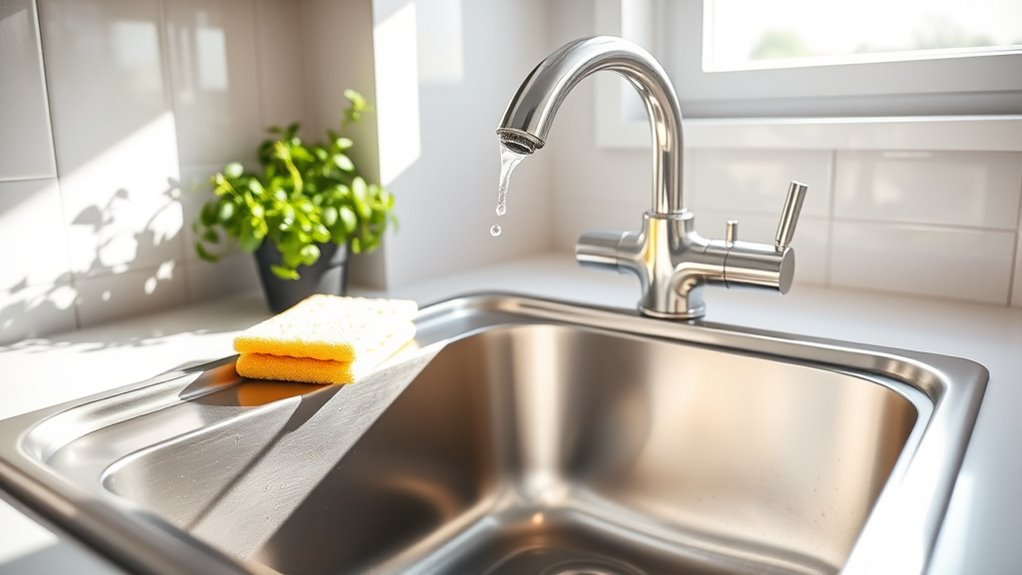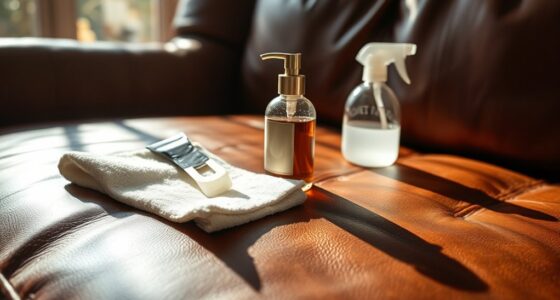To disinfect your kitchen sink, clear out all dishes and food scraps first. Scrub the sink with warm, soapy water, then rinse thoroughly. Apply a bleach solution (1 tablespoon bleach to a gallon of warm water) and let it sit for five minutes before rinsing again. Make it a habit to disinfect at least once a week, especially after handling raw meat, to keep bacteria at bay. There’s more to learn about effective cleaning techniques and tips!
Key Takeaways
- Clear all dishes and food scraps from the sink before starting the cleaning process.
- Scrub the sink with warm, soapy water using a sponge or scrub brush, then rinse thoroughly.
- Apply a bleach solution or hydrogen peroxide, allowing it to sit for at least 5 minutes for effective disinfection.
- Rinse the sink again with clean water to remove any cleaning residue, ensuring it’s safe for food preparation.
- Disinfect the sink at least once a week, especially after handling raw meat, to combat harmful bacteria.
The Importance of Disinfecting Your Kitchen Sink

While you mightn’t think twice about your kitchen sink, it actually harbors more germs than the bathroom faucet handles. Studies show that 45% of kitchen sink swabs test positive for coliform bacteria, highlighting the need to disinfect regularly.
Pathogens like salmonella, listeria, and E. coli thrive on food debris, which can lead to foodborne illnesses if left unchecked. Cleaning your sink daily to remove food particles is essential, but it’s not enough. Experts recommend disinfecting your kitchen sink at least once or twice a week, especially after handling raw meat, to eliminate harmful bacteria.
A thorough disinfecting routine not only improves your sink’s cleanliness but also enhances overall kitchen hygiene, safeguarding your family’s health.
Recommended Cleaning Frequency

To keep your kitchen sink clean and safe, aim to disinfect it once or twice a week.
If you’ve handled raw meat, it’s essential to clean and sanitize the sink immediately afterward.
Regularly addressing food debris also helps maintain a hygienic environment in your kitchen.
Weekly Disinfection Guidelines
Disinfecting your kitchen sink at least once a week is essential for maintaining a safe cooking environment.
Regular cleaning and disinfecting help reduce harmful bacteria like salmonella and E. coli that linger on food debris.
During your weekly deep cleaning, focus on the bottom and corners of the sink where grime accumulates.
Make sure to remove food debris daily to prevent odors and uphold hygiene standards.
Use an effective disinfectant to thoroughly clean the kitchen sink, ensuring you sanitize after every use, especially when handling raw meat.
This routine not only keeps your sink clean but also greatly reduces coliform bacteria, contributing to overall kitchen hygiene.
Prioritize this house cleaning task to protect your family’s health.
After Raw Meat Handling
After you’ve tackled your weekly cleaning routine, it’s important to pay special attention to your sink following any raw meat preparation.
Disinfecting it at least after each instance of raw meat handling is vital to eliminate harmful bacteria like salmonella, which can linger for up to 32 hours.
Experts recommend using a bleach solution or hydrogen peroxide immediately after you’ve finished.
The USDA advises that cleaning and sanitizing your sink after every use involving raw meat helps prevent cross-contamination and maintains a hygienic cooking environment.
Regular cleaning and disinfecting of your sink at least once or twice a week is also necessary, as neglecting this can lead to foodborne illnesses.
Prioritize consistent cleaning practices to keep your kitchen safe.
Cleaning Supplies You Will Need

To effectively disinfect your kitchen sink, you’ll need a few essential cleaning tools and solutions.
Gather dish soap, a scrub brush or sponge, and a bleach-based cleaner to tackle germs and grime.
You might also want to contemplate some optional supplies like Bar Keepers Friend for tough stains and denture tablets for porcelain sinks.
Essential Cleaning Tools
When tackling the task of disinfecting your kitchen sink, having the right cleaning supplies on hand makes all the difference.
Start with dish soap; it cuts through fats and oils, making cleaning the sink easier. A scrub brush or sponge is vital for scrubbing away stuck-on food and grime from the sink’s surface.
If you have a stainless steel sink, consider using Bar Keepers Friend for any stubborn stains. Don’t forget a sink strainer to catch food scraps and prevent clogs, especially if you lack a garbage disposal.
Finally, a bleach or bleach-based cleaner is essential to kill bacteria like salmonella and guarantee your sink is truly disinfected.
With these tools, you’re well-equipped for the task!
Recommended Cleaning Solutions
With the right tools in hand, it’s time to focus on the cleaning solutions that will help you achieve a sanitized kitchen sink.
Start with soapy water, using dish soap to cut through any fats or oils. For a more thorough clean, consider Bar Keepers Friend to tackle tough stainless steel stains.
To disinfect your kitchen effectively, hydrogen peroxide is a great choice; its 3% solution is non-toxic and safe for most surfaces. Alternatively, you can use bleach by mixing one tablespoon with a gallon of warm water, ensuring you have proper ventilation.
Just remember not to mix it with ammonia-based cleaners. These solutions will help you properly disinfect your kitchen sink and maintain a hygienic space.
Optional Cleaning Supplies
Having the right supplies makes disinfecting your kitchen sink much easier and more effective. While dish soap, a scrub brush or sponge, and bleach are essential for cleaning and disinfecting, you might want to take into account some optional supplies to enhance your efforts.
For instance, a sink strainer is great for catching food scraps, keeping your sink clean and preventing clogs. If tough stains are an issue, Bar Keepers Friend can work wonders, especially on stainless steel.
Additionally, denture tablets are useful for tackling stubborn porcelain stains. By using these optional supplies, you can guarantee your sink not only stays clean but also looks great while effectively killing bacteria during the disinfecting process.
Step-by-Step Guide to Cleaning Your Sink
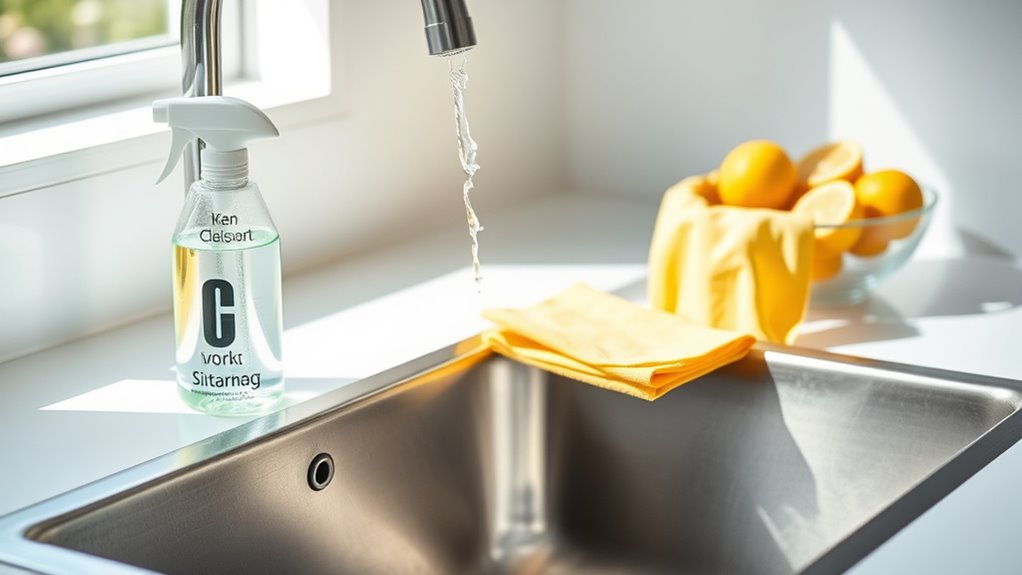
Cleaning your kitchen sink effectively involves a few simple steps that can make a big difference in maintaining hygiene.
Start by clearing out all dishes and food scraps to provide a clean surface. Next, use warm, soapy water and a sponge to scrub the sink, focusing on removing grease and stuck-on particles. Rinse thoroughly to wash away any residue.
To disinfect, apply a solution of hydrogen peroxide or a bleach mixture (1 tablespoon per gallon of water) and let it sit for at least 5 minutes. After disinfecting, rinse the sink again with clean water to verify it’s safe for food preparation.
Remember to clean your kitchen sink weekly, or more often if you handle raw meat, for peak sanitation.
Effective Disinfection Methods
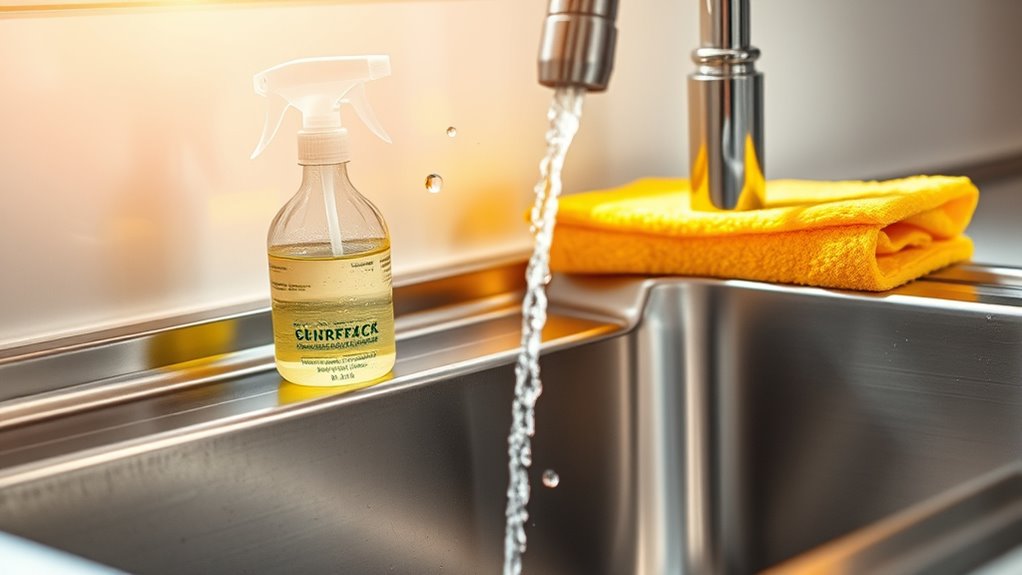
To keep your kitchen sink free from harmful bacteria, you can choose from several effective disinfection methods. Here are some options to evaluate:
- Bleach solution: Mix 1 tablespoon of bleach with a gallon of warm water, scrub all surfaces, and let it sit for five minutes.
- Hydrogen peroxide: Use a 3% solution and allow it to sit for at least 30 seconds before rinsing.
- Baking soda and vinegar: Sprinkle baking soda in the sink, scrub, then pour vinegar over it to tackle odors and bacteria.
- Regular disinfection: Aim to disinfect your sink at least once a week to combat bacteria like salmonella and E. coli.
- Post-meat handling: Always disinfect with bleach or hydrogen peroxide after handling raw meat to eliminate lingering bacteria.
Handling Raw Meat in the Sink

Maintaining a clean kitchen sink is particularly important when handling raw meat, as improper practices can lead to the spread of harmful bacteria. Rinsing raw meat isn’t necessary and can actually spread bacteria like salmonella and E. coli from the meat to your sink and other surfaces.
These harmful bacteria can linger on food debris for up to 32 hours if you don’t properly disinfect the sink. Instead of rinsing, make sure you cook raw meat thoroughly to kill any bacteria.
After preparing raw meat, it’s essential to disinfect your sink immediately using a bleach solution or another suitable disinfectant to prevent cross-contamination. Keeping your sink clean safeguards your health and maintains a hygienic kitchen environment.
Alternatives to Bleach for Disinfection

While bleach is a common choice for disinfecting kitchen sinks, there are several effective alternatives that can keep your space germ-free without the harsh chemicals.
Consider trying these options:
- Hydrogen peroxide: A non-toxic disinfectant that’s safe for most surfaces.
- Vinegar: Mix equal parts with warm water to create a gentle disinfectant.
- Baking soda: Combine with vinegar for a powerful drain cleaner that eliminates odors.
- Commercial sanitizers: Look for products that claim to “kill 99.9% of bacteria” for effective disinfection without bleach.
- Regular use of hydrogen peroxide: A 3% concentration helps maintain a bacteria-free environment, especially after handling raw meat.
Incorporating essential oils into your cleaning routine can enhance the effectiveness of these alternatives while providing natural antibacterial properties.
These alternatives guarantee your sink remains clean and safe for food preparation!
Tips for Maintaining a Clean Sink

Keeping your kitchen sink clean is just as important as choosing the right disinfectant. To maintain a hygienic space, disinfect your sink at least once a week.
Remember, your sink can harbor more bacteria than your bathroom faucet! After handling raw meat, thoroughly sanitize the area to eliminate harmful bacteria like salmonella and E. coli.
Your kitchen sink can hold more bacteria than your bathroom faucet, so sanitize it thoroughly after handling raw meat.
For effective cleaning, use a combination of baking soda and vinegar or hydrogen peroxide, which are safe and non-toxic. Before you clean, clear out any food scraps and debris to allow better exposure of the surface to your sanitizing agents.
Finally, develop a daily routine of cleaning and sanitizing after food preparation to prevent odors and bacteria buildup, ensuring a fresh kitchen environment.
Additional Resources for Kitchen Cleaning
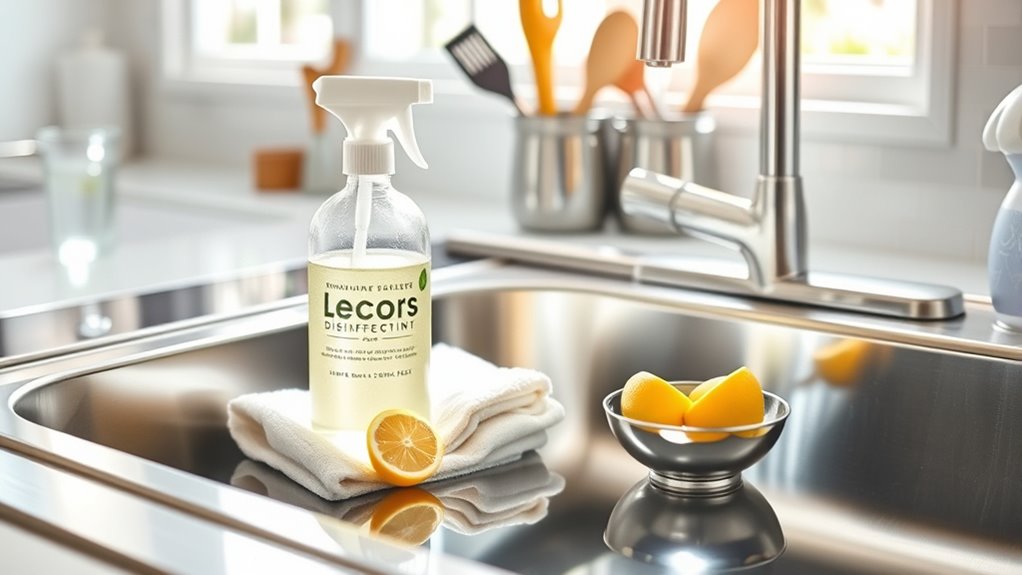
To enhance your kitchen cleaning routine, consider exploring various resources that can guide you in choosing effective products and techniques.
Regularly disinfecting your kitchen sink is essential for combating bacteria and maintaining hygiene. Here are some helpful resources:
- NSF Studies: Learn about the prevalence of coliform bacteria in kitchen sinks.
- Bleach Solutions: Discover the proper mix of bleach for effective sanitization.
- Hydrogen Peroxide: Find out how this non-toxic alternative can safely disinfect surfaces.
- DIY Drain Cleaners: Explore baking soda and vinegar mixtures for odor control.
- Commercial Sanitizers: Investigate products designed for efficient cleaning and bacteria elimination.
Incorporating these resources into your routine guarantees you effectively manage kitchen hygiene.
Frequently Asked Questions
How Do I Disinfect My Kitchen Sink?
To disinfect your kitchen sink, start by cleaning it with warm, soapy water to remove any dirt and food scraps.
After that, mix one tablespoon of bleach in a gallon of water and scrub all surfaces. Let it sit for five minutes to effectively kill bacteria.
Alternatively, you can spray hydrogen peroxide directly onto the sink, waiting at least 30 seconds before rinsing.
Regular disinfection is key to keeping your kitchen safe and sanitary.
What Is the Best Disinfectant for Kitchen Sinks?
When choosing the best disinfectant for kitchen sinks, consider safety, effectiveness, and ease of use.
Hydrogen peroxide’s non-toxic nature makes it a great option, while a bleach solution can kill nearly all bacteria when used properly.
Vinegar offers a safer, everyday alternative that still packs a punch.
Just remember to let your chosen disinfectant sit for a few minutes to maximize its germ-fighting power, ensuring your sink stays clean and hygienic.
How Do I Get Rid of Bacteria in My Sink?
To get rid of bacteria in your sink, you’ll want to use a reliable disinfectant regularly.
Mix hydrogen peroxide and baking soda to create a powerful solution that eliminates odors and harmful bacteria. After handling raw meat, be sure to disinfect thoroughly, as bacteria can linger.
You can also use a bleach solution, letting it sit for five minutes before rinsing.
Finally, always clean with soft cloths to protect your sink’s surface.
Can You Use Clorox Wipes on a Kitchen Sink?
Yes, you can use Clorox wipes on your kitchen sink, but make sure to check the manufacturer’s instructions first.
Wipe the surface thoroughly, ensuring it’s free of food debris for the best results. Let the wipes sit for the recommended contact time to effectively kill bacteria and viruses.
Just remember, don’t use them on porous surfaces or materials sensitive to bleach, like certain stainless steels or colored sinks. Always prioritize safety!
Conclusion
By keeping your kitchen sink sparkling and sanitized, you’re not just fighting germs; you’re creating a safe haven for culinary creativity. Think of it as a canvas—every meal starts here, and a clean surface lets your cooking artistry shine. Remember, a little daily care goes a long way, turning your sink into a shining beacon of hygiene. So grab those cleaning supplies and give your sink the love it deserves; your kitchen will thank you!

